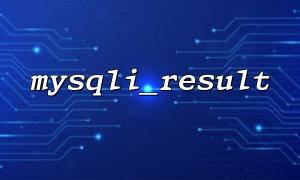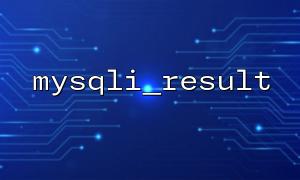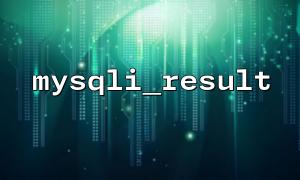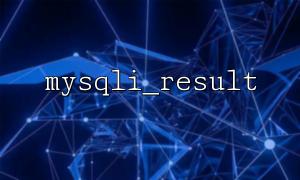In PHP, many times we need to get data from the database and return it in JSON format, such as providing an API interface for the front-end. To do this, you can use the mysqli extension to execute the query, and then use the json_encode() function to encode the result array into a JSON string.
This article will explain how to implement this process step by step.
First, you need to use mysqli to create a connection to the database:
$servername = "localhost";
$username = "db_user";
$password = "db_password";
$database = "db_name";
$conn = new mysqli($servername, $username, $password, $database);
// Check if the connection is successful
if ($conn->connect_error) {
die("Connection failed: " . $conn->connect_error);
}
Let’s take querying a table named users as an example to obtain all user data:
$sql = "SELECT id, username, email FROM users";
$result = $conn->query($sql);
Here $result is a mysqli_result object, which contains the query results.
Since json_encode() cannot directly encode the mysqli_result object, we need to convert it into an array first:
$data = array();
if ($result->num_rows > 0) {
while($row = $result->fetch_assoc()) {
$data[] = $row;
}
}
Here we use the fetch_assoc() method to take out each row of data as an associative array and add it to the $data array.
Now that we have the array $data containing all the query results, we can convert it to JSON format using json_encode() :
$jsonResult = json_encode($data);
// Output JSON data
header('Content-Type: application/json');
echo $jsonResult;
Here we also set the Content-Type header to application/json to tell the client that the JSON format is returned.
Combining the above steps, the complete code is as follows:
<?php
$servername = "localhost";
$username = "db_user";
$password = "db_password";
$database = "db_name";
$conn = new mysqli($servername, $username, $password, $database);
if ($conn->connect_error) {
die("Connection failed: " . $conn->connect_error);
}
$sql = "SELECT id, username, email FROM users";
$result = $conn->query($sql);
$data = array();
if ($result->num_rows > 0) {
while($row = $result->fetch_assoc()) {
$data[] = $row;
}
}
$conn->close();
header('Content-Type: application/json');
echo json_encode($data);
?>
Make sure the database connection information (such as username, password, database name) is correct.
In actual projects, for security and performance, it is recommended to use prepared statements instead of direct splicing SQL.
If you want to test the interface, you can access it with a browser, for example:
https://m66.net/api/get_users.php
This way, you can directly obtain JSON user data in the browser or front-end code.
Related Tags:
json_encode JSON














